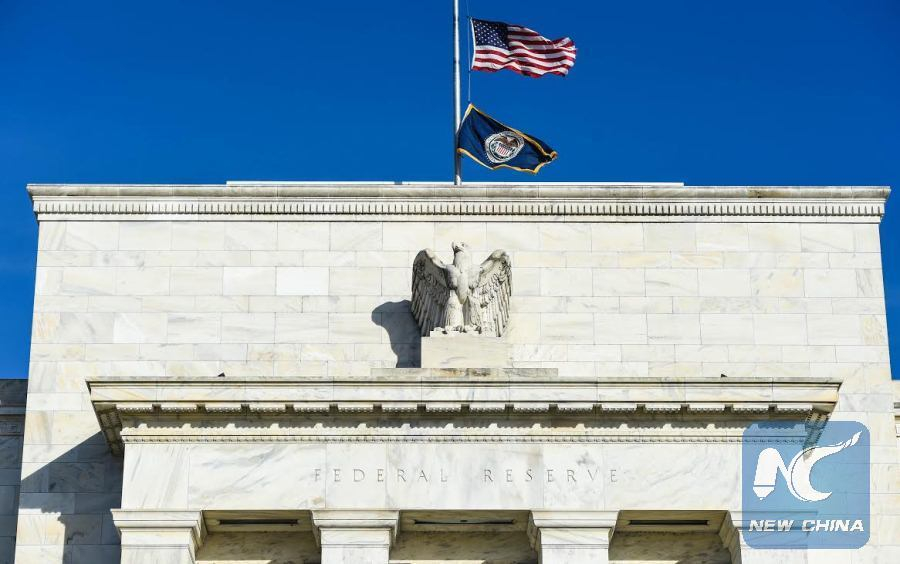
U.S. dollar banknotes. /Xinhua
U.S. dollar banknotes. /Xinhua
Editor's note: Huang Yongfu is an economic affairs commentator. After his Ph.D., he started working at the University of Cambridge and then moved on to the UN. He has authored many papers and books in the field of global development. His current interests lie in global development and Sino-U.S. ties, especially trade, financial and technological issues. The article reflects the author's opinions and not necessarily the views of CGTN.
The Wall Street Journal reported last week that later this month the U.S. may launch another multi-trillion-dollar stimulus package, in an attempt to prevent the current coronavirus crisis from causing a 21st-century Great Depression.
To blunt the impact of coronavirus pandemic that has staggered the U.S. economy, in just three weeks a divided Congress has reacted with uncharacteristic speed and unity by passing three major pieces of legislation.
The two trillion U.S. dollars package extends checks to households, bailouts to distressed industries, loans and grants to small business, additional resources to sap health-care providers, and additional funding to state and local governments.
In additional to that, President Trump signed the other two pieces of legislation, worth 8.3 billion U.S. dollars on March 3 and worth 100 billion U.S. dollars on March 18.
Can the government finance its deficits at zero cost?

The U.S. national flag. /Xinhua
The U.S. national flag. /Xinhua
With the coronavirus ravaging the U.S. economy over the past month, a number of leading progressive U.S. politicians and economists advocate some unorthodox policies such as monetary finance that uses the Federal Reserve's balance sheet to finance massive government programs mentioned above to improve America's economic resilience, inspired by the "modern monetary theory (MMT)."
The MMT dates back to the work of John Maynard Keynes entitled "A Treatise on Money" in 1930, whose valid insight being that governments and central banks together can always create nominal demand.
Mitchell, Wray, and Watts presented the MMT in their textbook of "Macroeconomics" in 2019, to which N. Gregory Mankiw offered a skeptic's guide on January 13, 2020.
Historically, both British and Italian governments with MMT-type approaches to policy during the mid-1970s ended up with resorting to the International Monetary Fund due to excessive reliance on inflationary finance. The Mitterrand government in France in 1981 and the Schröder government in Germany in 1998 were forced to revoke.
Proponents to MMT argue that "by printing money, the government can finance its deficits at zero cost," "no default risk on government debt," and "deficits don't matter or no financial constraints for countries that can borrow in their own currency."
The current MMT movement is to some extent spurred by the current U.S. government, characterized by long-term interest rates deliberately lower than the inflation rate and dollar becoming increasingly dominant in global trade and finance that enable governments to borrow cheaply with reduced burden of debt.
In fact, the current favorable conditions do not necessarily last forever, and mean real risks where high and rising debt can't be ignored. It is ludicrous to claim that excessive monetary finance is a costless route to solving long-term challenges without any burden on the economy.
Any money the government (via the Fed) prints to pay for a bill will stay in the banking system as reserves forever, expanding monetary base, bank lending, and money supply.
On the one hand, interest the government needs to pay on those reserves accrual over time. On the other hand, the massive economic-rescue package implies a substantial future tax increase, maybe as soon as next year, that would stymie the recovery.
Also, the overhang of debt and the expanded money supply will prevent central banks from raising rates so as to keep the cost of debt low and induce people to hold the expanded money supply. Low interest rates uplift aggregate demand, eventually buoying inflation.
Will a long period of subsequent recession follow?

The U.S. Federal Reserve building stands in Washington, D. C., capital of the United States, December 14, 2016. /Xinhua
The U.S. Federal Reserve building stands in Washington, D. C., capital of the United States, December 14, 2016. /Xinhua
The heightened challenge of coronavirus pandemic jitters together with record-low borrowing costs embolden governments around the world to draw up unprecedented economic relief plans, which are likely to outdo those employed to tackle previous crises.
For example, the U.S. two trillion dollars record-shattering package is twice as much as President Barack Obama's package in 2009.
The massive economic response is naturally pushing up sovereign-debt burdens for at least a few economies into a new territory. The U.S. has notched up its total government debt above 105 percent of GDP. Japan already has its public debt more than double its annual economic output.
In other OECD countries such as France, Italy, Spain, and the UK, large-scale fiscal stimuli are underway, driving their national debts close to 100 percent of GDP or much higher.
Traditionally, high debt reduces the room for fiscal maneuver to respond forcefully to economic downturns, undermine productive capacity and growth, and jack up interest rates and fiscal risks.
Based on more than 400 crisis episodes in 188 countries between 1980 and 2016, an IMF study published in January 2020 entitled "Debt is not free" found that, as an important harbinger of crises, sovereign debt shows a property of strong non-linearities in the sense that, if sovereign debt owed to foreign creditors exceeds certain threshold, the likelihood of entering a crisis increase sharply.
The thresholds for advanced economies and emerging-market economies are 70 percent and 30 percent of GDP, respectively.
Previously, Carmen M. Reinhart and Kenneth Rogoff in their seminal work in 2010 have identified a less stringent threshold, debt-to-GDP ratio above 90 percent typically having higher risks of crises and a dire effect on growth, where median growth rates falls by one percent while average growth falls considerably more.
The European Commission has set a threshold for debt level for the bloc, which is 60 percent of GDP.
The 2008 financial crisis was followed by the long period of recession, where loan growth turned negative for many years. Many economists believe that the depth of subsequent recession was due to the excessive leverage in the real economy where overleveraged households and companies were determined to pay down debt even if interest rates were zero.
Will the U.S. massive emergency relief package luckily induce a swift recovery and not necessarily a long period of subsequent recession?
(If you want to contribute and have specific expertise, please contact us at opinions@cgtn.com)